2120-Disclosure of Seat Dimensions FINAL
2120-Disclosure of Seat Dimensions FINAL.docx
Disclosure of Seat Dimensions to Facilitate the Use of Child Safety Seats on Airplanes During Passenger-Carrying Operations
OMB: 2120-0760
Department
of Transportation
Federal Aviation Administration
SUPPORTING STATEMENT
Disclosure of Seat Dimensions to Facilitate the Use of Child Safety Seats
on Airplanes During Passenger-Carrying Operations
OMB Control No. 2120-0760
INTRODUCTION
This information collection is submitted to the Office of Management and Budget (OMB) to request a three-year approval clearance for the information collection entitled Disclosure of Seat Dimensions to Facilitate the Use of Child Safety Seats on Airplanes During Passenger-Carrying Operations.
1. Circumstances that make collection of information necessary.
Section 412 of the FAA Modernization and Reform Act of 2012 (Public Law 112-95) specifically required the Federal Aviation Administration (FAA) to conduct rulemaking “[T]o require each air carrier operating under part 121 of title 14, Code of Federal Regulations, to post on the Internet Web site of the air carrier the maximum dimensions of a child safety seat that can be used on each aircraft operated by the air carrier to enable passengers to determine which child safety seats can be used on those aircraft.” The FAA requires air carriers to make available on their Web sites the width of the narrowest and widest passenger seats in each class of service for each make, model and series of airplane used in passenger-carrying operations. This rule amends 14 CFR 121.311.
2. How, by whom, and for what purpose is the information used.
This rule is intended to facilitate the use of child restraint systems (CRS) onboard airplanes. This rule provides greater information to caregivers to help them determine whether a particular CRS will fit in an airplane seat.
3. Extent of automated information collection.
Section 412 of Public Law 112-95 requires that all air carriers provide this required information on their Internet Web sites. Therefore, this information collection will be fully electronic.
4. Efforts to identify duplication.
FAA is the only Federal agency that requires this information to be provided to the public. This information disclosure is a result of a mandate in Public Law 112-95 for the FAA to conduct rulemaking to require this information disclosure. The FAA has also reviewed other FAA information disclosure requirements and find no duplication. Therefore, there is no duplication of any other requirements.
5.
Efforts
to minimize the burden on small businesses.
The Small Business Administration small entity size standard for air carriers is 1,500 employees or less. Of the 58 part 121 air carriers analyzed for this rule, 23 are classified as large entities and 27 as small entities. Employment statistics for the 8 remaining air carriers are not available; however, it is assumed that these 8 air carriers are small entities (for a total of 35 small entities).
Calendar year (CY) 2013 operating revenues were compared to the estimated costs during year 1 of the rule. Of the 35 air carriers considered to be small entities, operating revenue data were only available for 31 of them. For the 31 air carriers reporting financial data to the Bureau of Transportation Statistics, the estimated cost of this rule was no greater than .06 percent of any carrier’s CY 2013 operating revenues. The FAA believes a compliance cost of .06 percent relative to annual revenue is not a significant economic impact.
As stated in the Regulatory Flexibility Act analysis, the head of the FAA expects that the recordkeeping requirements of this final rule will not result in a significant economic impact on a substantial number of small entities.
6.
Impact
of less frequent collection of information.
The vast majority of this burden occurs on a one-time basis as air carriers initially provide information on their Web sites in order to comply with the regulation. After initial implementation, the only time air carriers would need to update their Web sites would be when a new airplane make, model, or series is introduced to an air carrier’s fleet, or when the narrowest or widest seat in a class of service in a currently listed make, model, or series of airplane is replaced with a narrower or wider seat. Failure to update a Web site when an air carrier adds a new aircraft make, model or series to its fleet or replaces an existing aircraft’s seats with a different model would result in non-compliance with the final rule information disclosure requirements. Failure to review the accuracy of the information on an annual basis could result in the air carrier’s display of incorrect seat dimension information.
7.
Special
circumstances.
There are no special circumstances associated with this information collection. The only time air carriers would need to update their Web sites after initial implementation would be when a new airplane make, model, or series is introduced to an air carrier’s fleet, or when the narrowest or widest seat in a class of service in a currently listed make, model, or series of airplane is replaced with a narrower or wider seat. This information collection is collected on an as-needed basis.
8. Compliance with 5 CFR 1320.8:
This collection was included in a notice of proposed rulemaking for which public comment was sought (79 FR 18212, April 1, 2014). The agency received no comments about this collection request.
9. Payments or gifts to respondents.
No payments or gifts were provided to respondents.
10. Assurance of confidentiality:
Air
carriers disclose information to third parties, including the public,
on their Web sites. The FAA does not collect any information. No
assurances of confidentiality are provided in this information
collection.
11. Justification for collection of sensitive information:
Questions of a sensitive nature are not included in this information collection.
12. Estimate of burden hours for information requested:
This rule requires Part 121 passenger air carriers to post seat dimension information to their websites. The labor required to comply with this rule is for the collection of information, thus the labor hours estimated for the regulatory evaluation equates to the paperwork hour burden. To estimate labor hours, the FAA used assumptions for job skills and labor hours from the regulatory analysis1 of the DOT’s recent “Enhancing Airline Passenger Protections”2 rule. One provision of the DOT’s rule requires an air carrier to post on its website a tarmac delay plan and a customer commitment plan, and the FAA believes that the skills and labor hours estimated for this task are similar to those required to post information about seat dimensions. In the DOT rule, it was estimated that it would take a computer programmer and a supervisor/manager a combined total of eight hours to post the customer commitment plan and tarmac delay plan to an air carrier’s website. The FAA is using the DOT estimate of eight hours as the foundation for the time required to perform the work required to comply with the seat dimension disclosure rule.
To show a range of costs for the 58 air carriers affected by this rulemaking, the FAA first estimated a low and high case of hours worked by staff (database and systems administrators) and management.3 The estimated hours consist of two components: base hours and variable hours. The base hour component is applicable to both staff and management. For staff, base hours represent the time it takes to identify the tasks required to post seat dimension disclosure information to an air carrier’s website. For management, base hours represent the time expended verifying that websites are in compliance with this rulemaking. Base hours are assumed to be equal across all air carriers
The variable hour component is only applicable to the staff labor group. It accounts for the incremental labor required to make websites compliant to this rule for air carriers operating a fleet of multiple aircraft makes, models and series, versus those that may operate only one make, model, and series of aircraft. Thus, the variable hour component increases for each make, model and series of aircraft operated by an individual carrier. Total paperwork costs of this rule are calculated by multiplying the hours expended for each of the labor groups by their respective hourly compensation, which are then summed across all carriers.
DERIVATION OF PAPEWORK HOUR BURDEN ESTIMATE – YEAR 1
Tables 1, 2, and 3 are provided to show derivation of labor hours on an individual carrier basis during year 1 of the final rule. A brief description of each table follows:
Table 1: This table shows the assumptions for staff and management hours that are used to calculate total labor hours required for an individual air carrier to comply with the seat dimension disclosure rule. (Again, the labor hours required to bring an air carrier’s website into compliance represents the paperwork burden). Assumptions for estimating labor hours are provided for both the low and high case.

Table 2: Table 2 shows the low case estimate for paperwork burden hours based upon each carrier’s count of make, model, and series of aircraft in its fleet. The estimate is derived using the assumptions in Table 1. Table 2 provides the paperwork hour burden for a carrier with a count of up to 14 different make, model, and series of aircraft (the most of any carrier at the time of this final rulemaking).
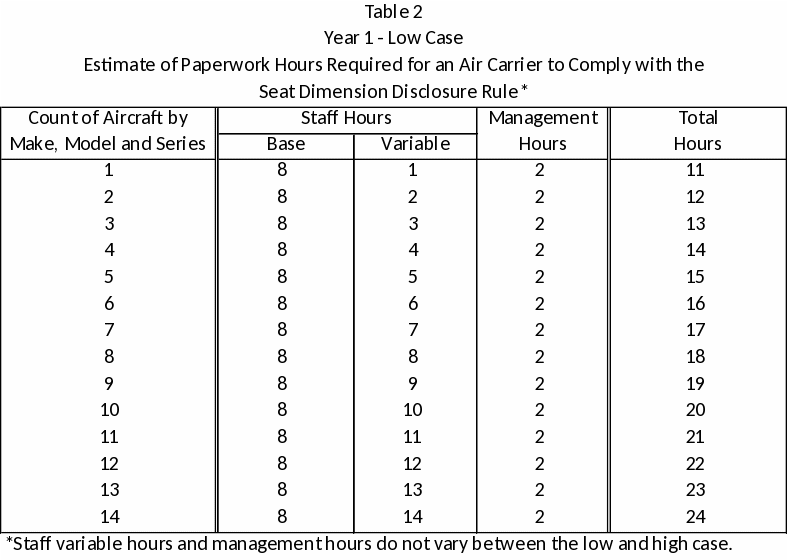
Table 3: Table 3 is similar to Table 2 except that it reflects the labor hour assumptions for the high case.
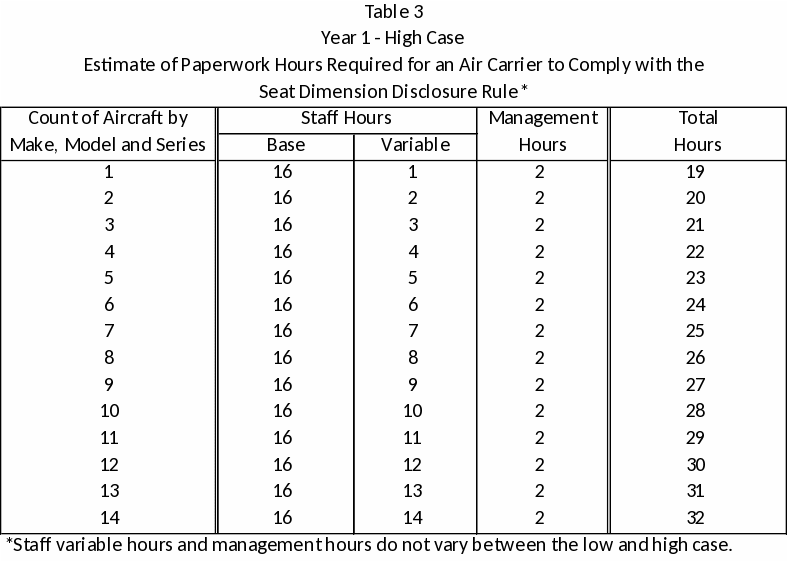
Example: Paperwork Hour Burden Computation for an Individual Air Carrier:
For illustrative purposes, the year 1 computation of the paperwork hour burden for a single carrier operating seven different make, model and series of aircraft in its fleet is provided for the low case. Looking at Table 2, a carrier operating a fleet of 7 different make, model and series of aircraft requires 17 hours to comply with the rule during year 1 of the rule’s implementation. The equation used to calculate the 17 labor hours is below:
[8 staff base hrs + (7 make/model/series * 1.0 staff variable hrs) + 2 mgmt hrs] = 17 hrs
Paperwork Burden Hours -- Summed Across All Carriers:
Tables 4, 5, and 6 are provided to show the summation of total hours across all air carriers to comply with the seat dimension disclosure rule. A description of each of these tables follows:
Table 4: Table 4 is a matrix showing the classification of the 58 affected websites by the following criteria:
The count of make, model, and series of aircraft in an individual carrier’s fleet.
Whether the air carrier primarily performs scheduled or nonscheduled operations (Note: This attribute is required only for the purpose of calculating costs and does not have a bearing on the computation of labor hours).
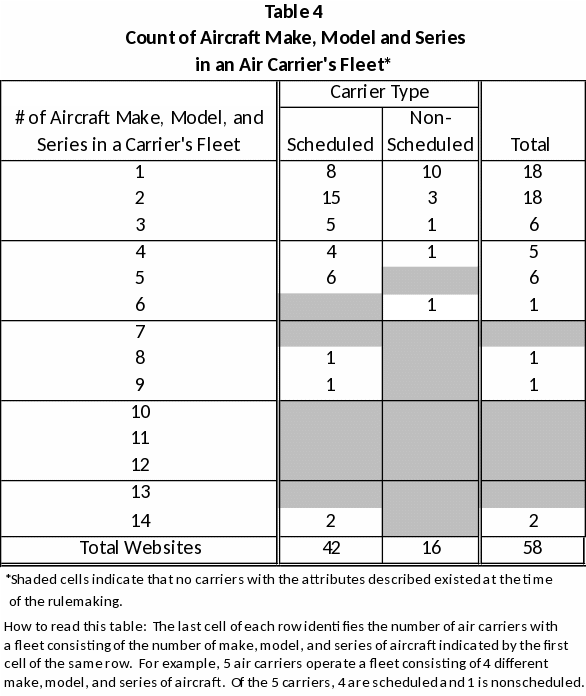
Table 5: Table 5 is derived by multiplying the labor hours from Table 2 by the corresponding cell values of Table 4 on a row-by-row basis. It is necessary to calculate hours for scheduled carriers independently of nonscheduled carriers since labor costs vary between the two.
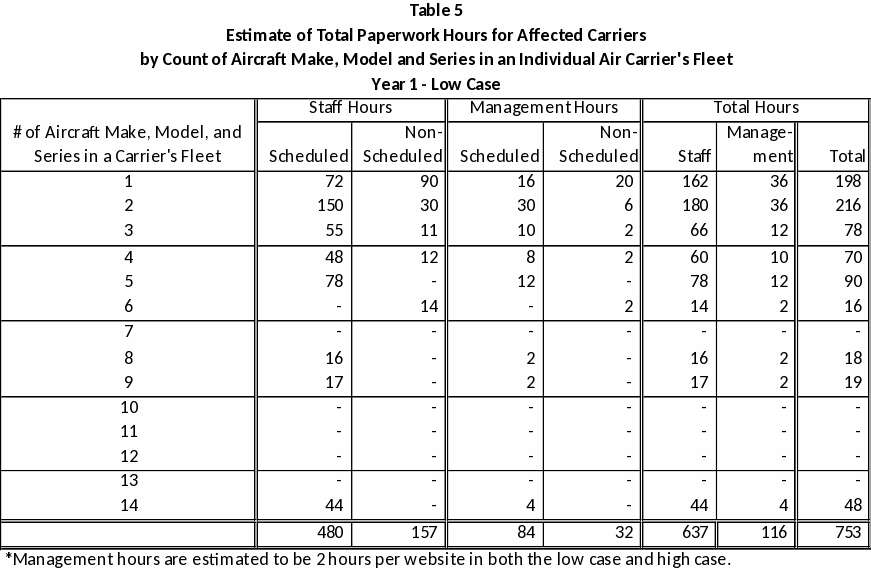
Example: Computation of Total Hourly Burden for Collection of Information - All Carriers (Based on count of Make, Model and Series of Aircraft in a Carrier’s Fleet):
For illustrative purposes, the total labor hours reported in row 3 of Table 5 (78 hours) is calculated below. Seventy-eight hours is the total paperwork burden hours computed for the 6 air carriers (Table 4, Line 3) that operate a fleet of 3 different make, model, and series of aircraft.
Staff Paperwork Hours:
Scheduled Air Carriers:
5 carriers * [8 base hours + (1 variable hour * 3 make/model/series)] =
55 scheduled air carrier staff hours
Nonscheduled Air Carriers:
1 carrier * [8 base hours + (1 variable hour * 3 make/model/series)] =
11 nonscheduled air carrier staff hours
Total Staff Hours:
55 scheduled hours + 11 nonscheduled hours = 66 staff hours
Management Paperwork Hours:
Scheduled Air Carriers:
5 carriers * 2 management hours =
10 scheduled air carrier management hours
Nonscheduled air Carriers:
1 carrier * 2 management hours =
2 nonscheduled air carrier management hours
Total Management Hours:
10 scheduled hours + 2 nonscheduled hours = 12 mgmt hours
Total Paperwork Hours:
66 staff hours + 12 management hours = 78 hours
Table
6: Table
6 is similar to Table 5 except that Table 6 reflects
the labor hour
assumptions for the high case.
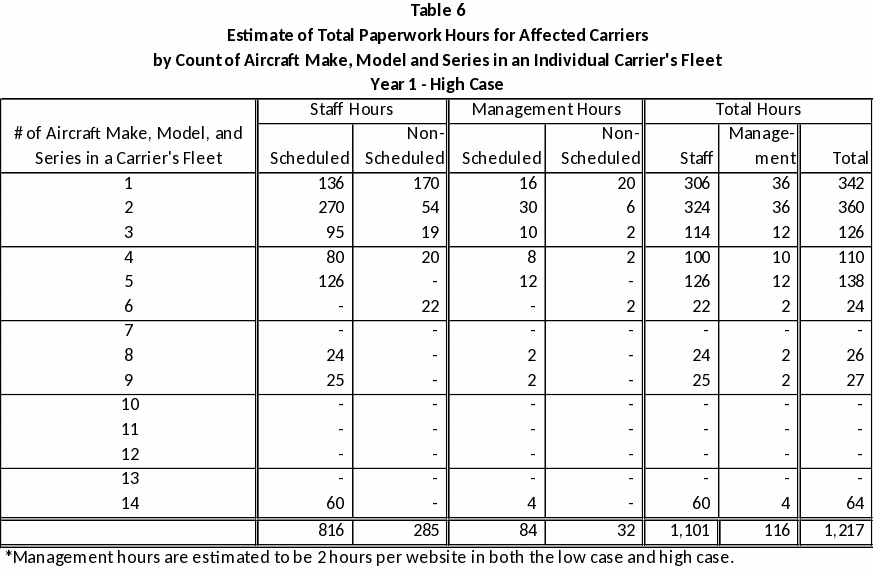
Labor Hours for Years 2 and 3:
For years 2 and 3 of the rule’s implementation it is assumed that through the ordinary course of business less time is required, relative to year 1, to maintain accuracy of seat dimension information posted to a carrier’s website. During these years, it is established that air carriers have already posted seat dimension information, thus air carriers may only need to revise the data periodically. Table 7 shows the total hours estimated for the paperwork burden in the low and high case during year two and year three.
In the low case, it is assumed that 5 hours per website are required on an annual basis to comply with the paperwork burden. The 5 hours consists of 4 staff hours and 1 management hour. In the high case, an annual total of nine hours (8 staff hours plus 1 management hour) per carrier is required for the paperwork burden. Summed across all carriers, a total of 290 hours in the low case and 522 hours in the high case will be required to comply with paperwork burden.
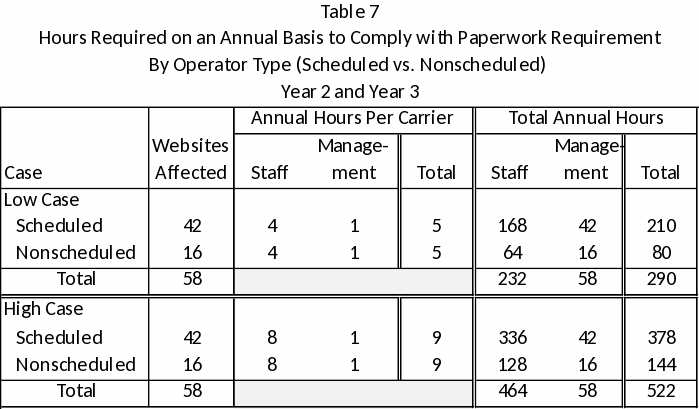
Respondents:
There are a total of 58 respondents. Each respondent maintains 1 website.
COSTS – Paperwork Burden Collection of Information:
Labor is the only cost associated with the collection of information for the rule. Tables 8 through 13 provide detail to show how the costs for the paperwork burden are calculated. Table 8: Table 8 contains the Bureau of Labor Statistics (BLS) fully-burdened staff and management wage rates for the work performed toward the collection of information.
Table 8 Assumptions: Hourly Wage and Benefits Compensation* |
||||||
NAICS** |
Job Series |
Job Category |
Job Title |
Hourly Wage |
Benefits*** |
Total Hourly Compensation |
481100 Scheduled Air Transportation |
15-1140 |
Staff |
Database and System Administrators and Network Architects |
$44.97 |
$19.00 |
$63.97 |
11-3021 |
Mgmt. |
Computer and Information System Managers |
$63.37 |
$26.77 |
$90.14 |
|
481200 Nonscheduled Air Transportation |
15-1140 |
Staff |
Database and System Administrators and Network Architects |
$35.21 |
$14.88 |
$50.09 |
11-3021 |
Mgmt. |
Computer and Information System Managers |
$53.43 |
$22.57 |
$76.00 |
|
*Source: U.S. Department of Labor, Bureau of Labor Statistics April 2014 Occupational Employment Statistics Survey (released in May 2013) (http://stat.bls.gov/oes/home.htm) **North American Industry Classification System – US Census Bureau ***Source: U.S. Department of Labor, Bureau of Labor Statistics News Release dated June 12, 2014 “Employer Costs for Employee Compensation – March 2013” Page 3- Table A. Hourly wage rates are 70.3 percent of total hourly compensation. (http://www.bls.gov/news.release/archives/ecec_06122013.pdf) |
||||||
Tables 9 and 10: Table 9 shows the low case cost estimate (on an individual carrier basis) for labor hours associated with the paperwork burden. These estimates are calculated by multiplying the paperwork burden hours identified in the low case (Table 2) by the fully-burdened wage rates (Table 8). Table 10 is similar to Table 9 except that it contains the high case estimate for paperwork burden costs. This estimate is calculated by multiplying paperwork burden hours identified in Table 3 by the wage rates in identified in Table 8.

Tables 11 and 12: The total paperwork burden costs associated with bringing all 58 websites of Part 121 passenger carriers affected by this rule into compliance are calculated by multiplying the fully-burdened wage rates shown in Table 8 by the paperwork burden hours in Table 5 (for the low case) and Table 6 (for the high case). The results of this calculation are shown in Tables 11 and Table 12. The bottom-right cell in each of these tables is the combined total paperwork burden cost for all carriers.
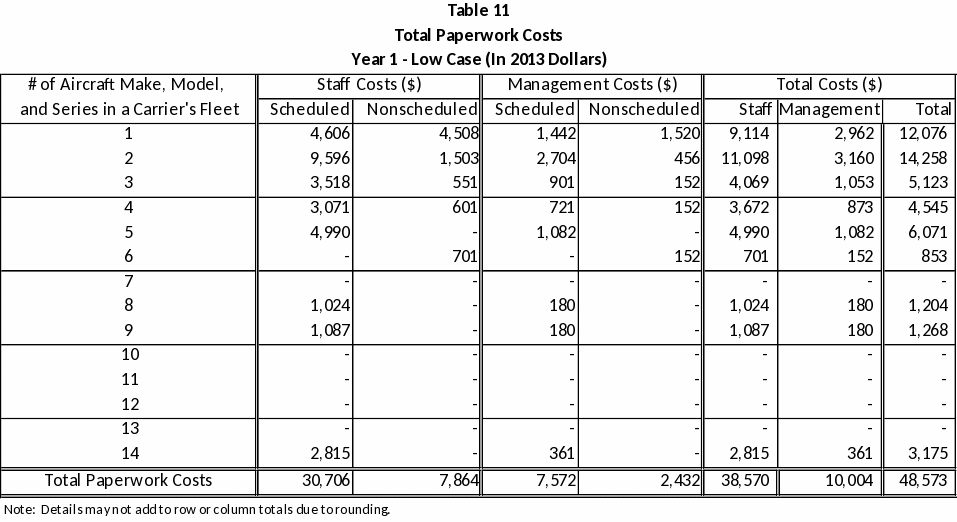
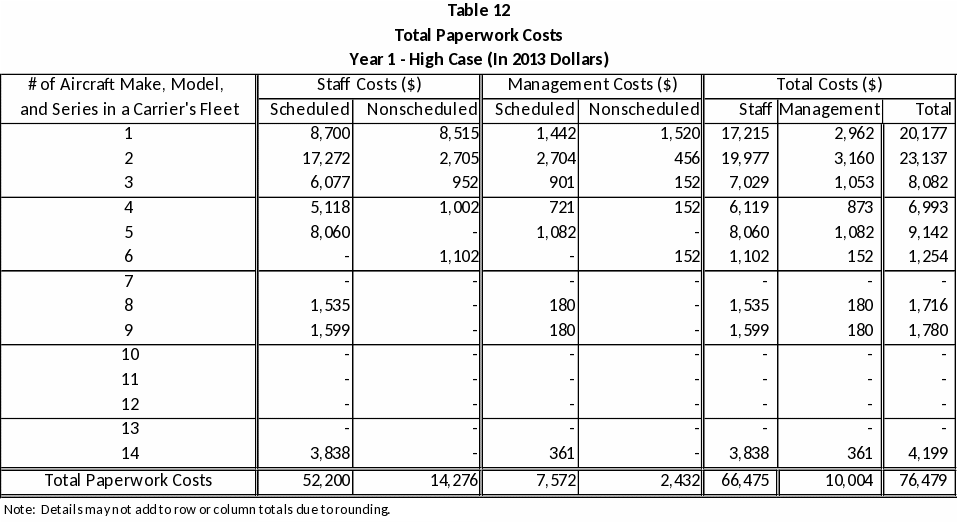
Paperwork Burden Costs for Years 2 and 3:
For years 2 and 3 of the rule’s implementation it is assumed that through the ordinary course of business less time is required than in year 1 to maintain accuracy of seat dimension information posted to a carrier’s website. The paperwork burden costs for years 2 and 3 are calculated by multiplying the paperwork burden hours shown in Table 7 by the fully-burdened wages rates shown in Table 8. The paperwork burden costs for the low and high case are shown in Table 13.
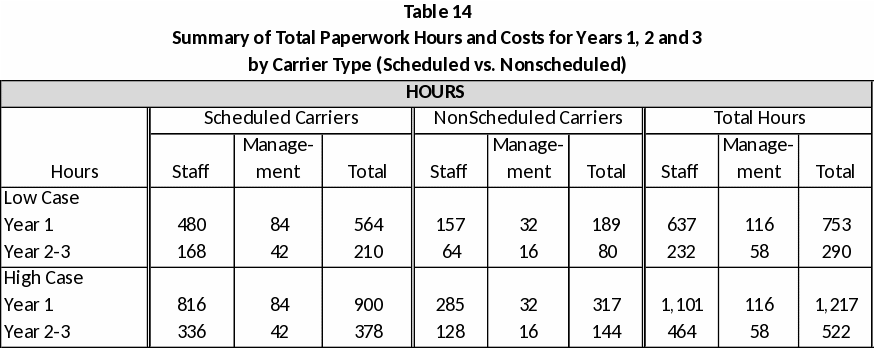
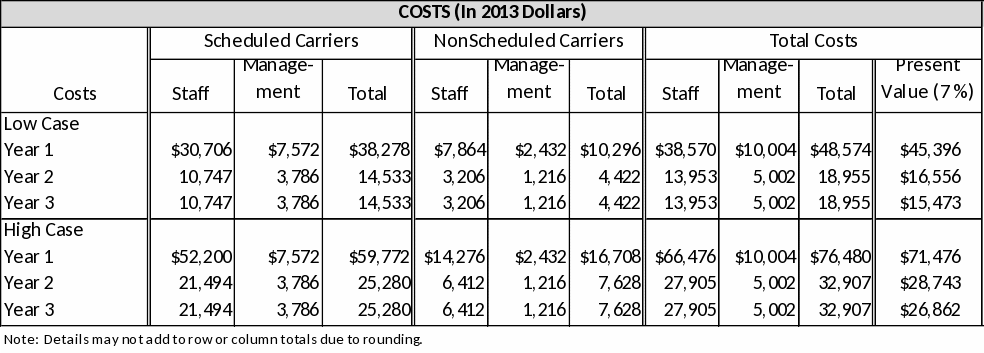
SUMMARY OF HOURS AND COST FOR YEARS 1-3
Table 14 summarizes paperwork burden hours and costs for the low and high cases during the first three years of the rule’s implementation.
13. Estimate of total annual costs to respondents.
The annualized cost (7 percent present value) for the paperwork hour burden during the first three years of the rule’s implementation is the average of the present value annualized cost for the low case and high case during the same three-year period. For the low case, the annualized cost for the paperwork burden during the first three years is $29,503 and for the high case the annualized cost is $48,424. The average of these two values is $38,963; thus, the annualized paperwork burden cost (7 percent present value) for the first three years is $38,963.
14. Estimate of cost to the Federal government.
There are no costs to the Federal Government associated with this information collection.
15. Explanation of program changes or adjustments.
This
is a new information collection, therefore it is a program change.
Section 412 of Public Law 112-95 requires this information
collection.
16. Publication of results of data collection.
The FAA does not collect or publish data as part of this information collection. This information collection is a third-party disclosure by air carriers on their Web sites.
17.
Approval
for not displaying the expiration date of OMB approval.
No such approval is sought because this information collection does not involve the use of a standard form to submit information to the agency.
18. Exceptions to certification statement.
The agency certifies compliance with all provisions of the Paperwork Reduction Act. There are no exceptions.
1 Final Regulatory Analysis, Consumer Rulemaking: Enhancing Airline Passenger Protections II at p. 43. This document can be found in Docket No. DOT-OST-2010-0140 or at http://www.regulations.gov/#!documentDetail;D=DOT-OST-2010-0140-2046.
2 76 FR 23110, April 25, 2011.
3 To estimate costs for this rule, labor hours are composed of staff hours and management hours. Staff hours are assumed to be performed by BLS Job Series 15-1140 - Database and Systems Administrators and Network Architects. Management hours are performed by BLS Job Series 15-3021 - Computer and Information Systems Managers.
| File Type | application/vnd.openxmlformats-officedocument.wordprocessingml.document |
| File Title | SUPPORTING STATEMENT |
| Author | AKENNEDY |
| File Modified | 0000-00-00 |
| File Created | 2021-01-24 |
© 2026 OMB.report | Privacy Policy